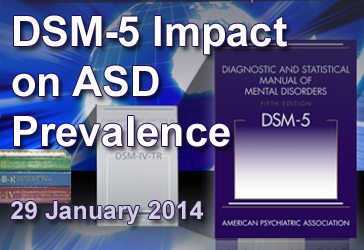Check out other stories from the Latest News
DSM-5 Criteria May Reduce ASD Prevalence, Slightly
By Shana R. Spindler, Ph.D. on January 30, 2014

Background: On May 18, 2013, the American Psychiatric Association released the fifth edition of the Diagnostic and Statistical Manual of Mental Disorders (DSM-5), providing guidelines for mental disorder identification. The previous version, DSM-IV-TR, used a three-domain approach to diagnose autism, including criteria for social interaction, communication deficits, and repetitive or restrictive behaviors. In contrast, the DSM-5 measures two domains—social aspects and repetitive behavior. Moreover, DSM-5 focuses on the range of symptoms and severity under a single Autism Spectrum Disorder (ASD) compared to specific subtypes, such as Autistic Disorder and Asperger syndrome, outlined in DSM-IV. These controversial changes have led some to question if the new version will catch all autism cases, which ultimately affects autism prevalence rates as well as access to therapy.
What’s new: In a population-based study, a collection of United States researchers found that DSM-5 criteria likely captures about 81 percent of existing autism cases. The researchers analyzed patient records from the Autism and Developmental Disabilities Monitoring (ADDM) network, a large multi-site surveillance system in the United States.
Of the 644,883 records assessed, a total of 6,577 records showed an ASD diagnosis using DSM-IV-TR criteria. When the researchers applied DSM-5 criteria to those same records, only 5339 patients still had ASD. Children with regressive history or intellectual disability and children who had originally been diagnosed by a community professional were more likely to meet all DSM-5 requirements. Surprisingly, 304 of 1020 children received an ASD diagnosis with DSM-5 criteria after narrowly missing an autism diagnosis according to DSM-IV-TR guidelines.
Why it’s important: Unlike previous clinic-based studies, the current study used a population-based system to examine how DSM-5 will affect autism prevalence, hopefully providing a more accurate assessment. Given that as much as 19 percent of autism diagnoses may change with the DSM-5 criteria, future studies examining changes in autism prevalence will need to take this into account.
Help me understand :
| Source(s) : |
| Tweet |

